How to Trust and Allow Space for the Picture Book Illustrator • by Natascha Biebow
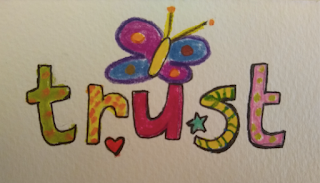
As apicture book writer, I often wish I had the talent of those author/ illustratorswho can write and illustrate. Theyhave a superpower in that they can mix and match the words and pictures, addinglayers and making choices to balance out the story so it is just right.
But, ifyou’re ‘just’ a writer, you have to allow space for the illustrator and thensit back and wait for the layouts to unfold into a fully-formed picture bookthat is just right. It’s an exercise in trust and letting go. The results areoften hugely gratifying, but it can be a scary process.
Will theillustrator capture the author’s vision?
What ifthey miss a key element or get it ‘wrong’?
Thetemptation can be to want to take control and to over-write or art-direct withillustration notes.
Intraditional publishing, authors work with a skilled team – a designer and aneditor, and sometimes also the publisher and art director – who are incrediblyexperienced and knowledgeable in the art of making picture books. They help topull together all the elements to create a seamless picture book that will captivateyoung readers. A lot of time, careful thought and revision goes into thisprocess, including choosing the right illustrator for each story.
What’sinteresting is that often illustrators add whole new storylines in the pictures– Pippa Goodhart recently blogged about this in her ‘The Joy of VisualSub-Plots’ post. These sub-plots are filled with lots of fabulous details tospot and mini-storylines to follow, making the book one to which young readerswill return to again and again.
Somethingelse spectacular often happens, though, when authors let go of their words andcreate space for illustrators:

Layersand depth!
Thelayers are created when illustrators springboard off the text to imagine the storyon the page – the key plot turning points, the setting and the characters, completewith individual personalities. Illustrators deepen the themes by attributing tothem a visual representation, making them accessible and relevant to youngreaders, who are often astute visual thinkers.
InterpretingThemes:
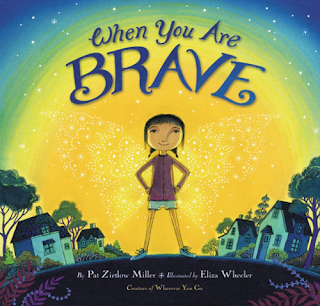 When You Are Brave by Pat Zietlow Miller and Eliza Wheeler
When You Are Brave by Pat Zietlow Miller and Eliza Wheeler
WHEN YOUARE BRAVE: Pat Zietlow Miller and Eliza Wheeler is the story of being bravewhen you have to do things in life that you’re much rather not do. The author’swords for the opening:
“Some days, when everything around you seemsscary,
you have to be brave.
“Brave as a bird that steps from its nest .. .
hoping to soar through the sky.
“Brave as a dog that wanders for miles . . .
searching for a well-known light.
“Brave as a caterpillar that builds a bed .. .
wondering where it will wake.
Because some days are full of things you’drather not do.”
These phrases could have been illustrated in so many different ways. ElizaWheeler depicts the situation as a girl’s family moving home
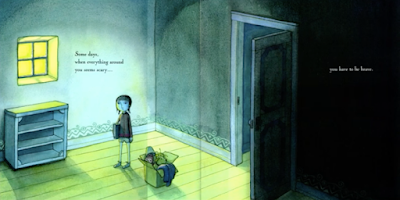 From When You Are Brave by Pat Zietlow Miller and Eliza Wheeler
From When You Are Brave by Pat Zietlow Miller and Eliza Wheeler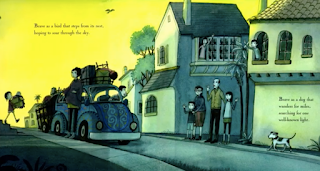 From When You Are Brave by Pat Zietlow Miller and Eliza Wheeler
From When You Are Brave by Pat Zietlow Miller and Eliza Wheeler
and creates aneat segue between the metaphorical, lyrical words by illustrating a physicalbird, dog, and caterpillar as the girl’s precious stuffed toys. Thus, Eliza helpsto make the abstract more concrete and relatable for young readers.
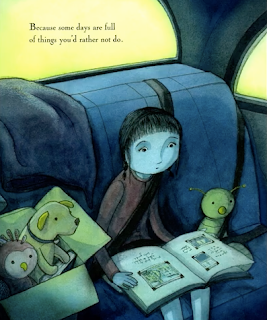 From When You Are Brave by Pat Zietlow Miller and Eliza Wheeler
From When You Are Brave by Pat Zietlow Miller and Eliza Wheeler
In THETRUTH ACCORDING TO ARTHUR by Tim Hopgood, David Tazzyman must depict what a completelyabstract character (The Truth) looks like and give it a personality.
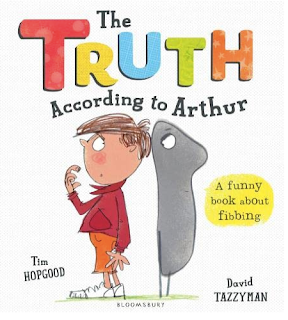 The Truth According to Arthur by Tim Hopgood and David Tazzyman.
The Truth According to Arthur by Tim Hopgood and David Tazzyman.
He deftly imaginesthe situations in which the boy bends, stretches, ignores and covers up The Truth.
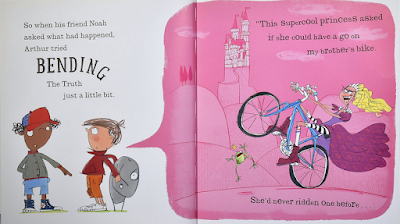 The Truth According to Arthur by Tim Hopgood and David Tazzyman.
The Truth According to Arthur by Tim Hopgood and David Tazzyman.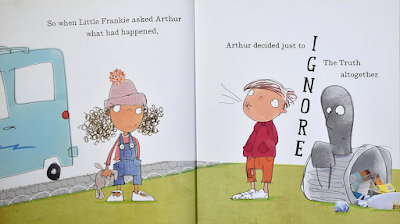 The Truth According to Arthur by Tim Hopgood and David Tazzyman.
The Truth According to Arthur by Tim Hopgood and David Tazzyman.
In I AMNEFERTITI by Annemarie Anang, Natelle Quek also artfully captures an abstractelement – music.
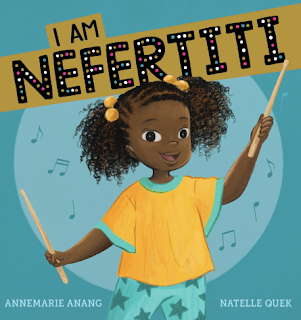 I Am Nefertiti by Annemarie Anang and Natelle Quek
I Am Nefertiti by Annemarie Anang and Natelle Quek
Natelle shows how the band feels and sounds when it makes musicthat is discordant and harmonious, even adding different colours for eachinstrument.
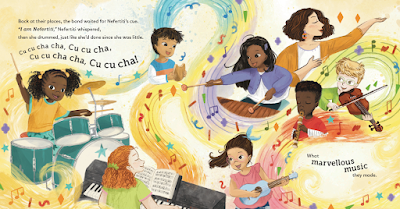 From I Am Nefertiti by Annemarie Anang and Natelle Quek
From I Am Nefertiti by Annemarie Anang and Natelle Quek
The main character, Nefertiti,is the drummer, who keeps the all-important beat in the band. But when her teacher shortens her name to ‘Nef’ because it’s easier topronounce, something shrinks inside her – both literally and figuratively. In orderto make this idea accessible to young readers, Natelle needed to showNefertiti’s physical transformation as well as how it felt. To convey this, shepositioned the main character tiny amongst the looming drums:
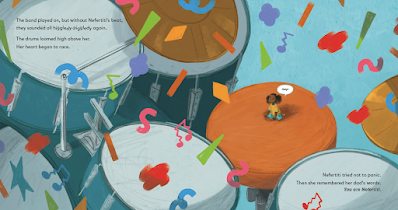 From I Am Nefertiti by Annemarie Anang and Natelle Quek
From I Am Nefertiti by Annemarie Anang and Natelle Quek
Characters& Their Worlds :
I AM NEFERTITI is a story about identity and belonging; the multicultural,diverse cast of band members is intrinsic to the narrative. Working from thestarting point of the author’s text (just the characters' names and their instruments),the illustrator and editorial and design team worked closely together toenvision what each child should look like:
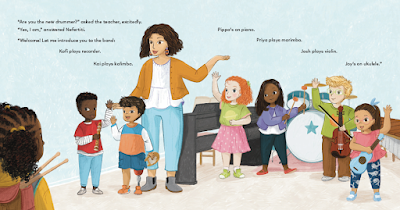 From I Am Nefertiti by Annemarie Anang and Natelle Quek
From I Am Nefertiti by Annemarie Anang and Natelle Quek
In JamesCatchpole’s WHAT HAPPENED TO YOU?, Karen George also creates an authentic groupof children, and sets them in the playground, cleverly juxtaposing the realwith the imaginary using blocks of solid colour.
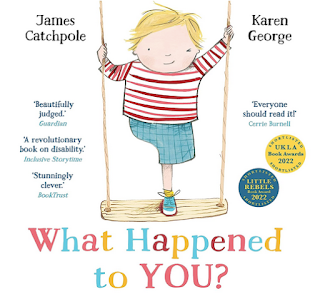 What Happened to You? by James Catchpole and Karen George
What Happened to You? by James Catchpole and Karen George
The maincharacter, Joe, says, “And there are sharks down here, too.
Theyespecially like to eat pirates.”
If youlook closely at this scene, Karen George adds all the drama of differentchildren’s reactions to the pretend play in their well-observed expressionsand body language. This is intuited in the dialogue between Joe and the curiouschildren, but not written explicitly into the text. It is more powerful thisway.
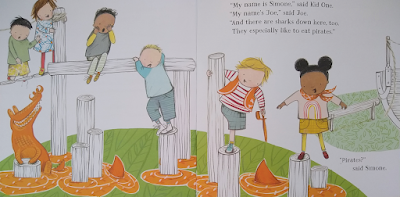 From What Happened to You? by James Catchpole and Karen George
From What Happened to You? by James Catchpole and Karen George
In LASTSTOP ON MARKET STREET by Matt de la Peña and Christian Robinson, a boy sets out on a bus journey withhis grandma.
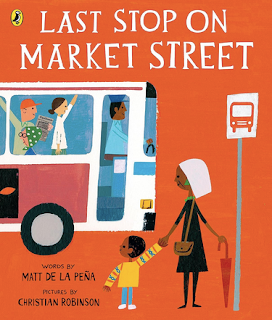 Last Stop on Market Street by Matt de la Peña and Christian Robinson
Last Stop on Market Street by Matt de la Peña and Christian Robinson
Readers are introduced to the people they meet, among them, a blind man andguide dog, a musician, and a woman with butterflies in a jar. The illustratorhas to decide: what kind of dog? What ages, ethnicities and backgrounds will thepeople be? What should they wear? How will young readers engage with thepictures. Will they see themselves and their backgrounds represented? And somuch more!
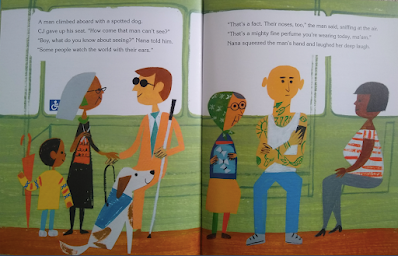 Last Stop on Market Street by Matt de la Peña and Christian Robinson
Last Stop on Market Street by Matt de la Peña and Christian Robinson
Similarly,in MY DADDIES! by Gareth Peter, the illustrator, Garry Parsons, imagines whatthis family looks like and how they act and react in each scene.
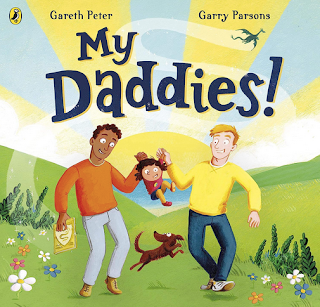 My Daddies! by Gareth Peter and Garry Parsons
My Daddies! by Gareth Peter and Garry Parsons
Theillustrator must imagine situations to best convey the layers and flesh out theaccompanying words. For instance:
“They’renot the best at everything . . .
(one dad is not a particularly good artist)
but Idon’t really care.”
(one dad is not a particularly good cook)
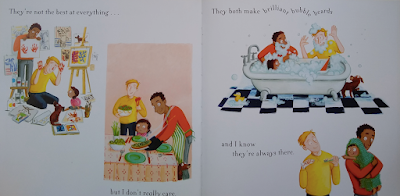 From My Daddies! by Gareth Peter and Garry Parsons
From My Daddies! by Gareth Peter and Garry Parsons
It’salmost as if the words are ‘coming true’.
Especiallypoignant, is the double-paged spread, where the child’s adoption story islovingly imagined and portrayed from babyhood to new, two-dad family home.
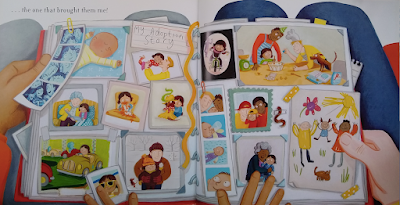 From My Daddies! by Gareth Peter and Garry Parsons
From My Daddies! by Gareth Peter and Garry Parsons
Theillustrator is essentially adding a 3-D version of the author’s words,envisioning the child’s adoption journey and the family’s home life, and makingit feel real and relatable to every young reader.
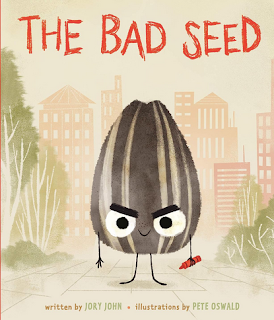 The Bad Seed by Jory John and Pete Oswald
The Bad Seed by Jory John and Pete OswaldIn THEBAD SEED by Jory John, Pete Oswald envisions what a ‘bad’ seed might look like:
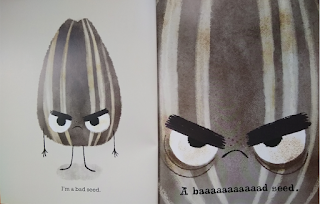 From The Bad Seed by Jory John and Pete Oswald
From The Bad Seed by Jory John and Pete Oswald
And what the seed might do when lying:
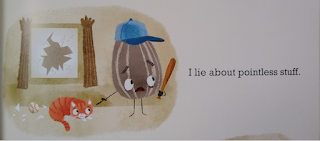 From The Bad Seed by Jory John and Pete Oswald
From The Bad Seed by Jory John and Pete Oswald
Or inwhich situation the seed might cut in line:
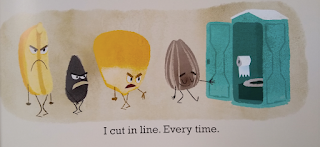 From The Bad Seed by Jory John and Pete Oswald
From The Bad Seed by Jory John and Pete Oswald And whatother bad things the seed might do:
 From The Bad Seed by Jory John and Pete Oswald
From The Bad Seed by Jory John and Pete Oswald
And what the seed might do when turned nice:
 From The Bad Seed by Jory John and Pete Oswald
From The Bad Seed by Jory John and Pete Oswald
Inessence, Pete Oswald has envisioned the ‘bad’ seed’s entire world and background, and madeimportant choices about how to convey the emotional journey of the maincharacter as readers turn the pages. This isn’t written into the author’s wordsper se, but as a finished picture book, it is so much richer with the illustrator’scontributions.
Finally,sometimes, the layers and depth of the message emerge in the form of a visualpunchline, such as in SUSAN LAUGHS by Jeanne Willis and Tony Ross.
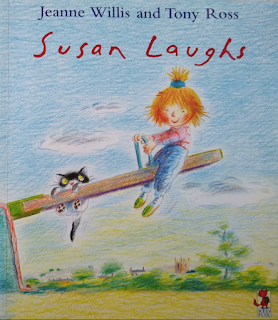 Susan Laughs by Jeanne Willis and Tony Ross
Susan Laughs by Jeanne Willis and Tony Ross
In thisbook, the space evoked by the words is filled with the pictures of Susanenjoying life just as any able-bodied child might. The detail in the pictures adds context about Susan's family, friends, and the activities she enjoys - for example "Susan flies" could have been interpreted in many different ways!
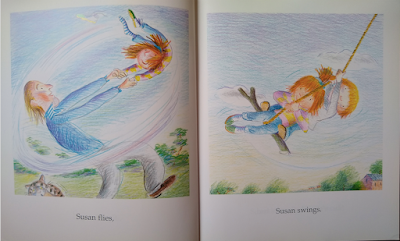 From Susan Laughs by Jeanne Willis and Tony Ross
From Susan Laughs by Jeanne Willis and Tony Ross
The final page shows Susanis in her wheelchair, and together with the preceding images, a picture of thewhole suddenly emerges – Susan as a child just like every other.
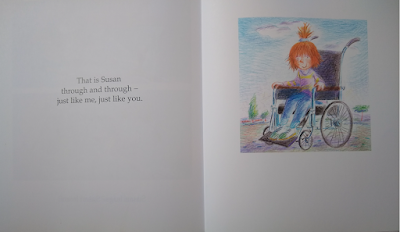 From Susan Laughs by Jeanne Willis and Tony Ross
From Susan Laughs by Jeanne Willis and Tony Ross
Nexttime, you’re tempted to be wordy, to add too much description, or even toover-art-direct a book, have faith. Think: could the illustrator add thoselayers? Time to trust!
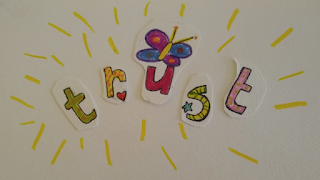
It’s totally worth it, and you’ll end up with a richerbook as a result.
_________________________________________________________________
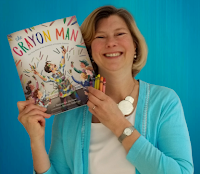 Natascha Biebow, MBE, Author, Editor, Coach and Mentor
Natascha Biebow, MBE, Author, Editor, Coach and MentorNatascha is the author of the award-winning The Crayon Man: The True Story of the Invention of Crayola Crayons, illustrated by Steven Salerno, winner of the Irma Black Award for Excellence in Children's Books, and selected as a best STEM Book 2020. Editor of numerous prize-winning books, she runs Blue Elephant Storyshaping, an editing, coaching and mentoring service aimed at empowering writers and illustrators to fine-tune their work pre-submission, and is the Editorial Director for Five Quills. Find out about her new picture book webinar courses! She is Co-Regional Advisor (Co-Chair) of SCBWI British Isles. Find her at www.nataschabiebow.com
@font-face {font-family:"MS 明朝"; mso-font-charset:78; mso-generic-font-family:auto; mso-font-pitch:variable; mso-font-signature:-536870145 1791491579 18 0 131231 0;}@font-face {font-family:"Cambria Math"; panose-1:2 4 5 3 5 4 6 3 2 4; mso-font-charset:0; mso-generic-font-family:auto; mso-font-pitch:variable; mso-font-signature:-536870145 1107305727 0 0 415 0;}@font-face {font-family:Calibri; panose-1:2 15 5 2 2 2 4 3 2 4; mso-font-charset:0; mso-generic-font-family:auto; mso-font-pitch:variable; mso-font-signature:-520092929 1073786111 9 0 415 0;}@font-face {font-family:"Arial Unicode MS"; panose-1:2 11 6 4 2 2 2 2 2 4; mso-font-charset:0; mso-generic-font-family:auto; mso-font-pitch:variable; mso-font-signature:-134238209 -371195905 63 0 4129279 0;}@font-face {font-family:"Helvetica Neue"; panose-1:2 0 5 3 0 0 0 2 0 4; mso-font-charset:0; mso-generic-font-family:auto; mso-font-pitch:variable; mso-font-signature:-452984065 1342208475 16 0 1 0;}@font-face {font-family:"Trebuchet MS"; panose-1:2 11 6 3 2 2 2 2 2 4; mso-font-charset:0; mso-generic-font-family:auto; mso-font-pitch:variable; mso-font-signature:647 0 0 0 159 0;}p.MsoNormal, li.MsoNormal, div.MsoNormal {mso-style-unhide:no; mso-style-qformat:yes; mso-style-parent:""; margin:0cm; margin-bottom:.0001pt; mso-pagination:widow-orphan; font-size:12.0pt; font-family:"Times New Roman"; mso-fareast-font-family:"MS 明朝"; mso-fareast-theme-font:minor-fareast; mso-ansi-language:EN-US;}a:link, span.MsoHyperlink {mso-style-priority:99; color:blue; mso-themecolor:hyperlink; text-decoration:underline; text-underline:single;}a:visited, span.MsoHyperlinkFollowed {mso-style-noshow:yes; mso-style-priority:99; color:purple; mso-themecolor:followedhyperlink; text-decoration:underline; text-underline:single;}p.Default, li.Default, div.Default {mso-style-name:Default; mso-style-unhide:no; mso-style-parent:""; margin-top:8.0pt; margin-right:0cm; margin-bottom:0cm; margin-left:0cm; margin-bottom:.0001pt; mso-pagination:widow-orphan; font-size:12.0pt; font-family:"Helvetica Neue"; mso-fareast-font-family:"Arial Unicode MS"; mso-bidi-font-family:"Arial Unicode MS"; color:black; border:none; mso-style-textoutline-type:none; mso-style-textoutline-outlinestyle-dpiwidth:1.0pt; mso-style-textoutline-outlinestyle-linecap:flat; mso-style-textoutline-outlinestyle-join:miter; mso-style-textoutline-outlinestyle-pctmiterlimit:400.0%; mso-style-textoutline-outlinestyle-dash:solid; mso-style-textoutline-outlinestyle-align:center; mso-style-textoutline-outlinestyle-compound:simple; mso-ansi-language:EN-US; text-underline:black;}.MsoChpDefault {mso-style-type:export-only; mso-default-props:yes; font-size:10.0pt; mso-ansi-font-size:10.0pt; mso-bidi-font-size:10.0pt; mso-fareast-font-family:"MS 明朝"; mso-fareast-theme-font:minor-fareast; mso-fareast-language:JA;}div.WordSection1 {page:WordSection1;}



